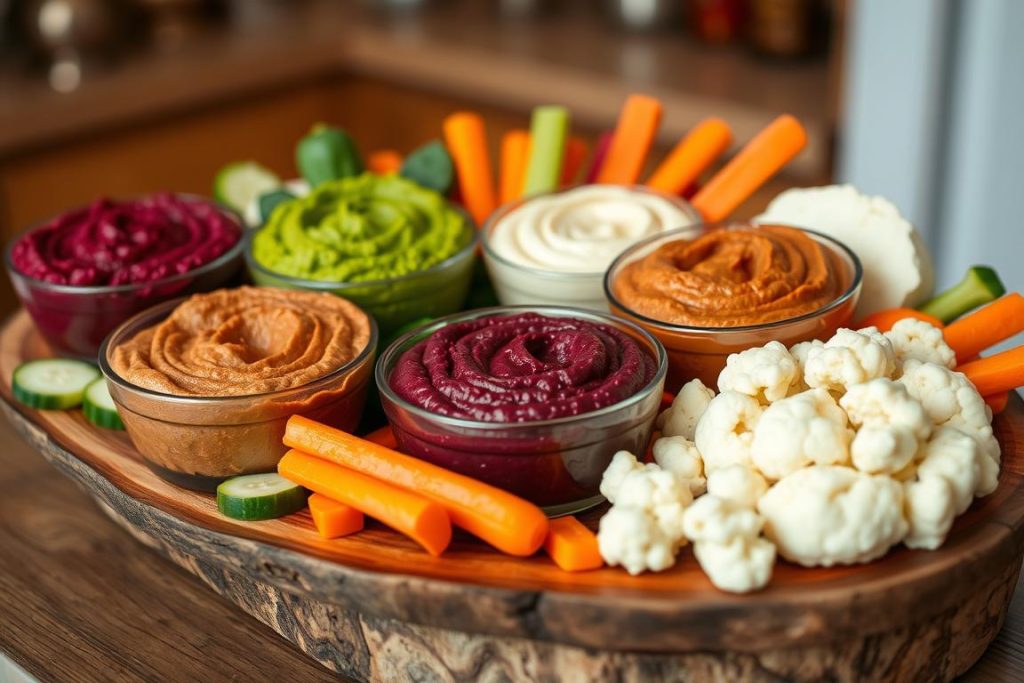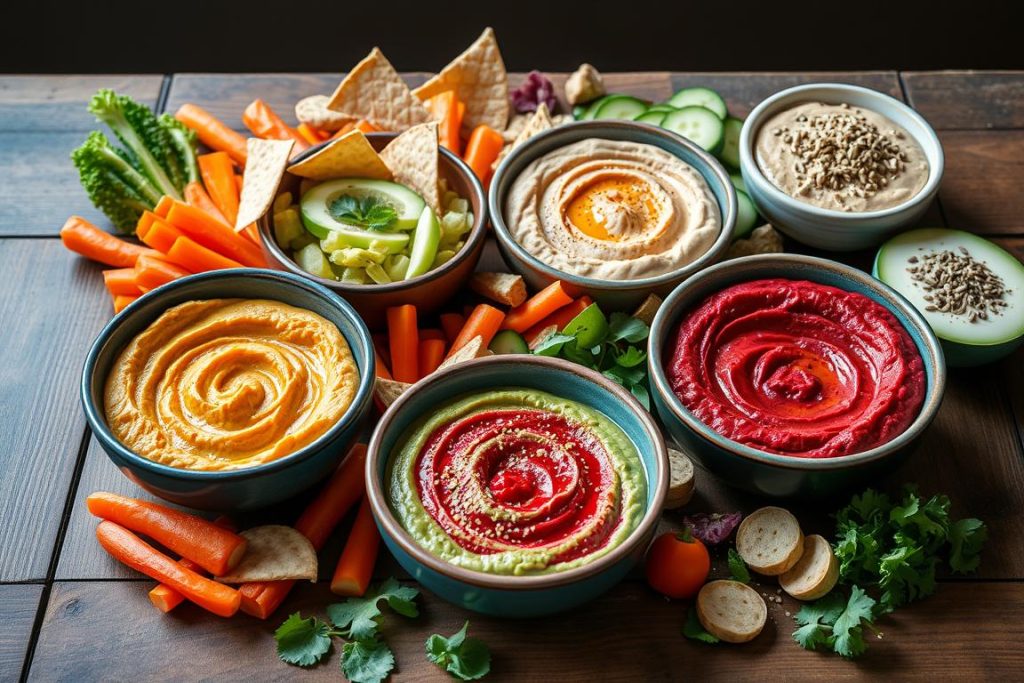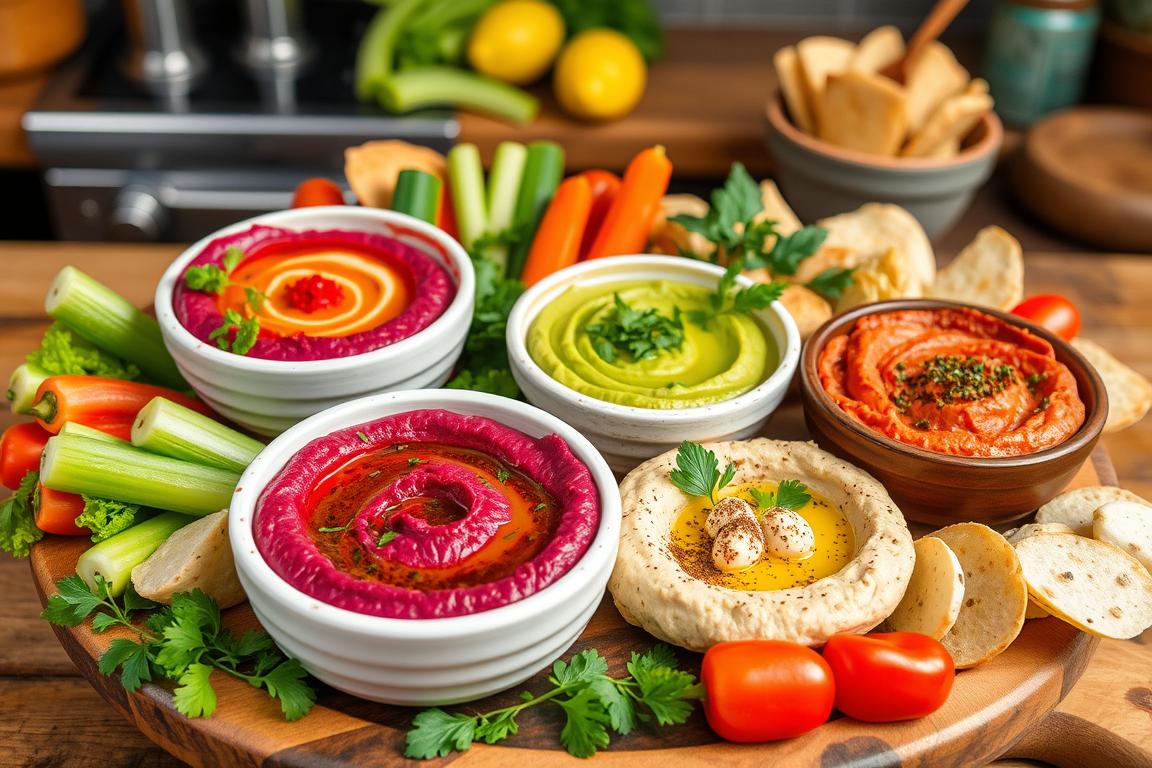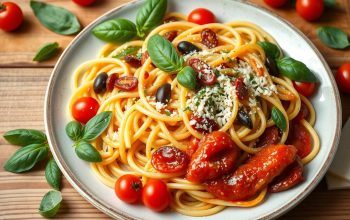Hummus, the beloved Mediterranean dip, is known for its creamy texture and rich flavor. But did you know it can be transformed into many creative variations? Explore beyond the traditional chickpea base and start a flavor journey that will excite your taste buds.
As more people around the world love hummus, home cooks and chefs are getting creative. They’re making hummus with vibrant vegetables and sweet and savory mixes. These new hummus ideas will make your meals more exciting and healthy.
In this guide, we’ll look at hummus’s history and how to make the perfect base. We’ll also explore innovative flavors from around the globe. So, grab your pita chips and get ready to discover the endless possibilities of this Mediterranean favorite.
The Evolution of Traditional Hummus: From Ancient Times to Modern Twists
Hummus, a favorite Middle Eastern cuisine dish, has a long and interesting history. It comes from the Levant region and is made from chickpeas, tahini, and spices. Over time, it has changed to suit different tastes worldwide.
The first records of hummus are from the 13th century. They show a chickpea spread in Egyptian and Levant cookbooks. The hummus flavors have grown, influenced by the Mediterranean, North Africa, and the Caucasus. This has led to many different versions.
The big change in hummus was adding tahini, a sesame paste. This made it smooth and creamy. As it became popular, chefs and home cooks started adding new ingredients. They used things like roasted red peppers and sun-dried tomatoes, making hummus exciting and varied.
| Historical Milestones in Hummus Evolution | Impact on Hummus Flavors |
|---|---|
| 13th Century: Earliest documented recipes in the Levant and Egypt | Traditional Middle Eastern flavors: chickpeas, tahini, lemon, garlic |
| 20th Century: Hummus spreads to the Mediterranean and North Africa | Influence of regional spices and ingredients: za’atar, olives, roasted peppers |
| 21st Century: Global adaptation and experimentation | Diverse and innovative flavor combinations: sweet, spicy, fusion-inspired |
Now, hummus is loved as a vegetarian appetizer and ingredient globally. Each culture adds its own twist to this ancient dish. From classic Middle Eastern recipes to new, worldwide flavors, hummus keeps surprising and delighting us.
Essential Ingredients for Perfect Base Hummus
Making the best hummus starts with the right ingredients. From top-notch tahini to the best chickpeas and olive oil, each part is key. Let’s dive into the must-haves that turn simple chickpea hummus into a rich, tasty treat.
Selecting Premium Tahini
Tahini, the creamy sesame paste, is hummus’s core. For a deep, nutty taste, choose a smooth, well-balanced tahini. Go for tahini from unhulled sesame seeds for a richer flavor than hulled ones.
Choosing and Preparing Chickpeas
- Pick fresh, quality chickpeas for the best taste and texture.
- For smooth hummus, peel and cook chickpeas until tender and mashable.
- Try different chickpea types, like plant-based dips, for new tastes.
The Role of Quality Olive Oil
Top-notch extra virgin olive oil is the final touch for amazing hummus recipes. Choose a fruity, peppery oil that matches the tahini and chickpeas. It boosts the flavor and makes the hummus creamy.
| Ingredient | Importance | Recommended Varieties |
|---|---|---|
| Tahini | Provides the signature nutty flavor and creamy texture | Unhulled sesame seeds for a richer taste |
| Chickpeas | The main base for the hummus, offering a smooth, velvety consistency | High-quality, freshly cooked chickpea hummus |
| Olive Oil | Enhances the overall flavor and lends a luxurious mouthfeel | Fruity, peppery extra virgin olive oil |
With careful selection and preparation of these key ingredients, you can make a hummus recipes that looks great and tastes amazing. Take your plant-based dips to the next level with these tips.
Popular Hummus Variations Around the World
Hummus, a favorite Middle Eastern dip, has won hearts worldwide. The classic chickpea recipe is still loved, but new flavors have emerged. These variations celebrate the tastes of various cultures.
In the Mediterranean, hummus gets a local twist. Greek hummus adds bold Kalamata olives and tangy feta. Lebanese hummus includes a sweet touch from pomegranate molasses. Moving east, Turkish hummus is known for roasted red peppers and a hint of cumin.
- Middle Eastern Hummus: Chickpea-based with tahini, garlic, and lemon
- Greek Hummus: Kalamata olives and feta cheese
- Lebanese Hummus: Pomegranate molasses for a touch of sweetness
- Turkish Hummus: Roasted red peppers and cumin for a smoky flavor
In Asia, hummus gets a new twist too. Indian hummus warms with cumin and coriander. Japanese hummus adds miso paste’s umami. And Thai hummus mixes chickpeas with lemongrass and kaffir lime.
The love for hummus keeps growing, with each culture adding its own twist. Whether you stick to traditional Middle Eastern flavors or want to try global ones, there’s always something new to discover.
Mediterranean-Inspired Hummus Creations
Hummus, a favorite Middle Eastern dip, has grown beyond its chickpea roots. We’ll look at three Mediterranean-inspired hummus flavors. They’ll take your taste buds on a trip to the Mediterranean’s sunny coasts.
Sun-Dried Tomato and Basil Blend
Our sun-dried tomato and basil hummus is a hit. It mixes the sweetness of sun-dried tomatoes with basil’s fresh aroma. It’s a celebration of Mediterranean dips and great with vegetarian appetizers.
Kalamata Olive and Feta Fusion
Our Kalamata olive and feta hummus brings Greece to your plate. It’s a mix of salty olives and creamy feta. It’s perfect with fresh pita, veggies, or on Mediterranean bruschetta.
Roasted Red Pepper Excellence
Our roasted red pepper hummus adds vibrant color and sweetness. The red peppers add a rich flavor to the chickpea base. It’s a Mediterranean dip that looks and tastes amazing.
These hummus flavors show how versatile and flavorful hummus can be. They mix Middle Eastern ingredients with Mediterranean produce and spices. Enjoy them with pita, veggies, or crackers for a unique taste experience.
Asian-Fusion Hummus Adventures
We’re starting an Asian-fusion odyssey in the world of hummus. Get ready for a mix of Middle Eastern and Asian flavors. These plant-based spreads will elevate your hummus game.
Picture a wasabi-ginger hummus that wakes up your senses. Or a curry-spiced hummus that feels like a trip to India. And don’t miss the sesame-miso hummus, with its rich, nutty taste.
- Wasabi-Ginger Hummus: This flavored hummus mixes Middle Eastern and Japanese flavors. It’s creamy with a spicy kick from wasabi and ginger.
- Curry-Spiced Hummus: This plant-based spread is inspired by India. It adds curry powder, turmeric, and spices to traditional hummus.
- Sesame-Miso Hummus: It combines tahini’s nuttiness with miso’s savory taste. This hummus variation is a unique and exciting flavor experience.
These Asian-fusion hummus adventures are not just tasty. They show the endless possibilities when we explore new recipes. So, get ready for a culinary journey that will broaden your taste and leave you wanting more.
Unique Vegetable-Based Hummus Alternatives
Hummus made with chickpeas is a favorite, but there’s more. Now, you can find hummus made with veggies. These new hummus types bring exciting tastes and extra nutrition from veggies.
Roasted Beet Hummus
Roasted beet hummus is a vibrant, sweet dip. The beets get sweeter when roasted. This hummus is creamy, with a hint of lemon and garlic.
Sweet Potato Variations
- Sweet potato hummus is creamy and sweet. It gets its orange color from roasted sweet potatoes.
- For spice, try sweet potato and chipotle hummus. It’s smoky and sweet, a bold dip.
Carrot Ginger Fusion
Carrot ginger hummus is fresh and zesty. It has grated carrots and ginger for a unique taste. It’s creamy and great with veggies.
Looking for new hummus flavors? These veggie-based hummus options are tasty and healthy. Try mixing veggies to find your favorite hummus variations, healthy snacks, and plant-based dips.

Spicy and Bold Hummus Variations
For those who love strong flavors, hummus has a lot to offer. Move past the usual chickpea mix and try new tastes. Add jalapenos, harissa, and chipotle peppers for a bold twist.
Jalapeno-Cilantro Hummus is a spicy treat. It mixes chickpeas with cilantro and jalapenos for a kick. You can tone it down with Greek yogurt or olive oil.
Harissa-Spiced Hummus is inspired by North African spices. It has smoked chili peppers, garlic, and spices like cumin and coriander. This hummus is bold and savory, great with pita or grilled meats.
Chipotle-Lime Hummus adds a smoky, zesty flavor. Chipotle peppers add a subtle heat, while lime juice and zest make it bright. It’s perfect with tortilla chips or as a burrito bowl spread.
Creating spicy hummus is about finding the right balance. Start with small batches to adjust the spice level. Add cooling touches like cucumber, feta, or olive oil to balance the heat.
Spicy hummus variations can take your dips to the next level. They’re perfect for those who love strong flavors. Try these and discover new tastes beyond the usual chickpea dip.
Sweet and Unexpected Hummus Flavors
Hummus is usually savory, made from chickpeas. But, there are endless ways to make it sweet and unique. From chocolate to pumpkin spice, these flavors add a twist to the classic dip.
Chocolate Dessert Hummus
Hummus can be a sweet treat too. Mix chickpeas with cocoa, maple syrup, and vanilla for a chocolatey dip. Enjoy it with fruit, graham crackers, or dark chocolate for a healthier dessert.
Pumpkin Spice Blend
As fall arrives, try a pumpkin spice hummus. Mix chickpeas with pumpkin, cinnamon, ginger, and nutmeg. It’s great with apple slices, cinnamon-sugar pita chips, or on pancakes and waffles.
Cookie Dough Innovation
For a unique hummus, try cookie dough. Blend chickpeas with brown sugar, vanilla, and chocolate chips. It’s a smooth, sweet dip that tastes like cookie dough. Serve it with graham crackers or pretzels for a tasty snack.
These sweet hummus flavors show that chickpea spreads can be more than savory. With creativity, the options for flavored hummus are endless.
Seasonal Hummus Variations for Every Occasion
Seasonal hummus variations add a new twist to the classic chickpea dip. They bring out the flavors of each season. From spring’s freshness to winter’s warmth, these recipes make any gathering special.
In spring, try herb-infused or lemon-garlic hummus. It’s a refreshing mix of greens, herbs, and citrus. It’s great for vegetarian appetizers and healthy snacks.
Summer brings grilled vegetable hummus, like roasted red pepper or zucchini-basil. These dips have a smoky taste. They’re perfect for outdoor events and al fresco dining.
| Seasonal Hummus Variations | Signature Ingredients | Best Pairings |
|---|---|---|
| Spring Herb Hummus | Chickpeas, tahini, fresh herbs (e.g., parsley, basil, dill), lemon juice | Whole-grain pita, crudités, grilled vegetables |
| Summer Grilled Vegetable Hummus | Chickpeas, tahini, roasted red peppers, zucchini, garlic, smoked paprika | Pita chips, raw veggie sticks, grilled flatbread |
| Autumn Squash Hummus | Chickpeas, tahini, roasted butternut squash, cinnamon, maple syrup | Whole-wheat crackers, apple slices, toasted pita wedges |
| Winter Cranberry Hummus | Chickpeas, tahini, fresh or dried cranberries, orange zest, walnuts | Endive leaves, toasted baguette slices, celery sticks |
Autumn brings butternut squash or pumpkin spice hummus. These dips are cozy and comforting. They pair well with warm spices and nuts.
Winter’s hummus has cranberries, orange, and walnuts. These dips are vibrant and nourishing. They’re great for holiday parties and cozy nights.
Using seasonal ingredients in your hummus recipes is exciting. It creates a variety of flavors for every season. These dips are perfect for any occasion, from spring brunches to winter gatherings.
Protein-Packed Alternative Bean Hummus
While chickpea hummus is loved, many other bean dips are just as good. Black beans, white beans, and lentils add new flavors and textures. They make the classic Mediterranean dip even better.
Black Bean Variations
Black bean hummus is creamy and full of flavor. It’s perfect for those who want a more filling dip. The black beans mix well with garlic, tahini, and lemon, making a tasty and healthy snack.
White Bean Alternatives
White bean hummus uses cannellini, navy, or Great Northern beans. These beans make the hummus light and fluffy. It’s great with fresh herbs, roasted garlic, or olive oil.
Lentil-Based Options
Lentils add a rich taste to hummus. Red, green, or brown lentils work well. This dip is packed with protein, fiber, and vitamins. Enjoy it with veggies, pita, or crackers.
Looking for more protein or new tastes? Try these bean hummus options. Mix and match beans, seasonings, and toppings to find your favorite.
Creative Hummus Toppings and Garnishes
Make your hummus experience even better with a variety of toppings and garnishes! There’s more than just chickpeas to explore. Try roasted chickpeas, herb-infused oils, toasted nuts, and colorful vegetable crisps. Each topping can turn your hummus into a Mediterranean-inspired masterpiece.
For a classic touch, add roasted chickpeas seasoned with za’atar or paprika. Their crunchy texture and bold flavors pair well with creamy hummus. Finish it off with a drizzle of garlic-infused olive oil or basil-infused balsamic vinegar for extra depth.
- Roasted Chickpeas
- Toasted Pine Nuts or Almonds
- Crispy Pita Chips
- Finely Chopped Parsley or Cilantro
- Diced Cucumber or Tomatoes
- Crumbled Feta Cheese
For a colorful twist, add vegetable crisps. Thin slices of roasted beets, zucchini, or bell peppers bring crunch and beauty to your hummus.
Don’t be afraid to mix and match to find your favorite flavors and textures. The possibilities are endless. Let your creativity shine and make your hummus even more delicious!
Health Benefits of Different Hummus Variations
Hummus, a favorite plant-based dip, is packed with nutrients. It’s made from chickpeas and is a key part of many healthy snacks. But, did you know its health benefits can change based on the ingredients used? Discovering the health aspects of various hummus types opens up a world of tasty and nutritious choices for those who care about their health.
At its core, traditional chickpea hummus is a nutritional powerhouse. Chickpeas, or garbanzo beans, are rich in plant-based protein, fiber, and complex carbs. This mix makes chickpea hummus a filling and satisfying snack that aids in weight management and digestive health.
Nutrient-Dense Variations
- Roasted Beet Hummus: Beets add a vibrant color and a boost of antioxidants, making this variation a nutritional superstar.
- Sweet Potato Hummus: Sweet potatoes contribute a natural sweetness, as well as a wealth of vitamins A and C, which support immune function.
- Carrot Ginger Hummus: The combination of carrots and ginger provides an anti-inflammatory punch, making this hummus a potential ally for heart health.
Heart-Healthy Hummus
Many hummus types include heart-healthy ingredients like olive oil, nuts, and seeds. The monounsaturated and polyunsaturated fats in these ingredients can help lower cholesterol levels and reduce the risk of cardiovascular disease when part of a balanced diet.
| Hummus Variation | Key Heart-Healthy Ingredients |
|---|---|
| Sun-Dried Tomato and Basil Hummus | Olive oil, pine nuts |
| Kalamata Olive and Feta Hummus | Olive oil, kalamata olives |
| Roasted Red Pepper Hummus | Olive oil, almonds |
Regardless of the ingredients, hummus can be a nutritious and versatile addition to a plant-based diet. By exploring the wide range of hummus variations, health-conscious consumers can find delicious and nutrient-dense options to satisfy their cravings for healthy snacks.

Storage and Serving Tips for Homemade Hummus
Homemade hummus is a tasty Mediterranean dip that can make any vegetarian appetizer better. To keep your homemade hummus fresh and tasty, follow these storage and serving tips.
Proper Container Selection
Choose an airtight container made of glass or BPA-free plastic for storing homemade hummus. Don’t use metal containers because they can change the taste. Sealed containers keep the hummus creamy and fresh for longer.
Temperature Considerations
Keep hummus in the fridge at 35°F to 40°F. This cool temperature slows down bad bacteria growth. It also keeps the dip’s flavor and texture good. Eat homemade hummus within 3-5 days for the best taste.
Serving Presentation Ideas
- Serve hummus in a shallow bowl and drizzle with high-quality olive oil for a visually appealing presentation.
- Garnish with chopped parsley, paprika, or a sprinkle of za’atar for a pop of color and flavor.
- Accompany the hummus with an assortment of fresh pita bread, carrot sticks, cucumber slices, and other Mediterranean-inspired dippers.
By following these tips, your homemade hummus will stay fresh, tasty, and a great addition to any vegetarian appetizer spread.
Conclusion
We’ve taken a journey through the world of hummus variations. From its ancient roots to modern twists, we’ve seen a lot. This journey has opened our eyes to endless culinary possibilities.
There’s something for everyone, from classic Mediterranean tastes to spicy and sweet surprises. Hummus is amazing because it can mix with so many ingredients. This lets us create our own special recipes.
Using hummus in your cooking adds to your skills and gives you a healthy snack or meal. As you try new hummus variations, chickpea spreads, and plant-based dips, remember it’s all about the fun. So, start experimenting and make your kitchen a place of delicious and healthy food.



